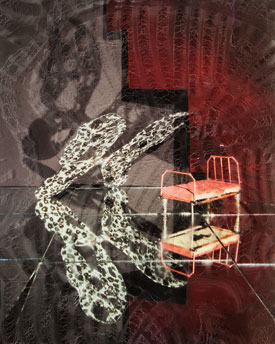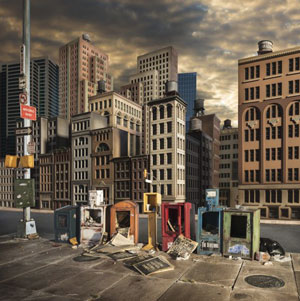Lurking Within
John Haberin New York City
Willa Nasatir and Everett Kane
Lori Nix and Kathleen Gerber
Willa Nasatir opens with swirls of color and black crashing into white. Everett Kane opens with half-remembered technology and films. Lori Nix and Kathleen Gerber recreate the fall of empires based on much the same.
All three series, though, are photographs. Two resolve into vivid interiors, the last into an imagined city, perhaps even New York. Nix and Kathleen Gerber have built its menace from scratch, with scale models. Where then are the people? When photography penetrates familiar surfaces and unfamiliar spaces, is it safe to enter? Is it possible, when all this is only art? 
Signs of life
Almost anything might be lurking in a photograph by Willa Nasatir, maybe even someone you know. She would insist otherwise, but should you trust her? Much of the appeal of her images lies in the elusiveness of what they represent and the evidence of deception. There is plenty of evidence, all from the last year alone. Nasatir works large, on the scale of a person, and in layers of objects and spaces. Walking into her exhibition at the Whitney is like entering a room in which not even harsh museum lighting can fully penetrate the darkness.
You might stumble on it coming off the large floor for Hélio Oiticica, the Brazilian artist. They appear as different as night and day. Oiticica loved the plainness of simple geometry and wide open spaces for visitors, or "participants," to enter. From his early constructions in Rio to photographs on a Manhattan rooftop, he wanted art to feel alive and free. Nasatir makes her work impenetrable, although she, too, likes the sensation of floating. Ghostly whites hover uncertainly over electric colors and sheer black.
They present at first a cascade of color, although nearly half the small show is black and white. Several color photos hang side by side on the wall facing the entrance, like a single unstable space. They hold more photographs parallel to the picture place, along with larger and equally cryptic objects. The work in black and white, most often smaller, looks denser to the point of abstraction. Both could seem primarily about the choice of chromogenic or gelatin silver prints for their own sake, all mounted on wood. Both, too, could almost pass for photograms.
Nasatir's cascading shapes have much in common with work today between photography and abstract painting, like that of Eileen Quinlan, right down to signs of craquelure. They are, though, always about something. She starts with assemblages of found objects, like Christine Rebhuhn today, and then the manipulation continues with photography and rephotography. A cart in the foreground of one image could be stacked objects or stacked images. A speckled rag running down that same photo repeats itself for sure. While she tends to avoid digital manipulation, the electric colors belong to a digital age, and it takes a moment to realize that they are almost all red, yellow, and blue.
What they are not are people, although they have every sign of life. A cart like that one could stand beside a patient's bed in a hospital, and the rag, to judge by the photography's title, has become a butterfly. Vertical shapes could stand for people or empty clothing, and shadows run beneath them. Most images look like interiors, with the ambiguity of interiors for Tim Wilson in paint, and they do take place in her studio. Titles, though, speak of a bird, a hitchhiker, a sunbather, and Coney Island. Did I mention that installations for Oiticica include live birds and sand?
The ambiguity of inhabited and empty, static and busy, inside and out, helps explain why the spaces seem both deep and claustrophobic. They could be sites for forbidden experiments, like scenes for Kane, and two are The Red Room and The Green Room. The interest in pre-digital equipment from an artist barely old enough to remember it resembles Kane's as well. A photo in black and white might represent a control tower, and another appears to perch a bus on top of the bus depot. Mostly, though, they seem safe enough to enter. You never know whom you might encounter within.
A failure to communicate
Everett Kane would make anyone afraid to inhabit his interiors. He has me afraid, too, that I already have. I could almost call a neatly made bed in a room lined with bookshelves my own. I could almost call the equipment that shares his spaces my past. A college roommate had a tape deck much like that, and we envied his sophistication. School must have had pretty much the same film projector, and a gallery not so very long ago would have called it new media.
This is not, though, an exercise in nostalgia—or not entirely, for without the appeal it could not be half as disturbing. Kane recalls sepia prints and untitled film stills, but in the silvery chill of black and white. The furnishings are devoid of life, and anyone tempted by their sculptured perfection might be in for punishment on that ground alone. An old organ and a music box defy recognition, and their pedals and pins might serve more sinister purposes now. Besides, these are digital prints and exercises in computer manipulation. They have left their sources behind.
A show called "Ground" is bound to look for common ground, but also to question whether the viewer or the equipment is grounded. One print even had me thinking of an electric chair. A film projector targets not a screen, but a chair in a cage. The same projector runs in Kane's sole video, but nothing is showing, at least for now. It might be in rehearsal for an interrogation or for filming it, for wider consumption. It might be bearing down on the empty chair like a weapon.
Then again, as Sigmund Freud might say, sometimes a projector is just a projector. The combination of gadgetry and a smaller bed might be an instrument of torture or medical care. Some might feel the same way about an actual hospital. The apparatus pointing at the double bed is still more mysterious. It might be a pair of projectors or jet engines going nowhere. Hotel rooms these days come with all sorts of amenities.
Kane sticks to old-fashioned communication equipment where communication has broken down. The cage is set deep in the background, where it looks all the more trapped, and the rooms lack for doors or windows. They become a space for rehearsing one's fears and remembering one's past—and a rather attractive space at that. They look like a cross between domestic and factory interiors, both out of an earlier era. They might even be settings for a silent comedy. As Freud might add, laughing at one's past is just the start of overcoming one's fears.
Becky Suss, too, looks into empty interiors, but they feel like home. Large paintings look at rooms head on, their horizontal format aligning them with the facing wall, as if to bar entry. The grids of shelves, doors, and flooring flatten them further, as do the uniform areas of color. Yet the lighting recalls earlier American painting, and they invite a look deep within—into more distant rooms or simply closets. Smaller paintings rummage through their contents, like books, in a style that at times recalls samplers, but they, too, as for Hollis Sigler are no mere exercise in nostalgia. They belong to family, friends, and the space of memory.
Unnatural disaster
If you think that Penn Station is a disaster area, you should visit a gallery only a couple of blocks away. Something has devastated New York, in photographs by Lori Nix and Kathleen Gerber, but without touching its everyday grandeur. Indeed, they enhance its beauty, making it hauntingly familiar but unlike anything you ever knew. Where the commuter terminal is cramped and overcrowded, their city is open to the skies and devoid of human life.  Where the first has harsh artificial light reflecting off dreadful public toilets and dreary flooring, their apparent sunlight lends the plainest of buildings a comforting warmth. And where the first suffers from one delay after another, their empire after a disaster has all the time in the world.
Where the first has harsh artificial light reflecting off dreadful public toilets and dreary flooring, their apparent sunlight lends the plainest of buildings a comforting warmth. And where the first suffers from one delay after another, their empire after a disaster has all the time in the world.
Empire, you ask? That word supplies the show's title, and it dominates the inscription on an arch much like that in Washington Square or Brooklyn's Grand Army Plaza, but somewhere else entirely. It is one of many signs that this New York has an alternative history, more like science fiction than the course of actual real-estate empires. The ravaged shell of what could be the Flatiron building lacks access to Madison Square as well. A street sign marks Division Street, but it leads not to Chinatown but to a dead end. Could division be a metaphor for whatever brought this on?
No doubt, but this empire looks to have been reasonably benign, give or take its end. It did not censor the newspapers that litter Manhattan streets. Rather, whatever invasion or insurrection brought on this devastation has blown up a cluster of those plastic dispensers for a free press, leaving their surroundings intact. The papers scattered about announce gloom and doom, but that, too, disrupts history. Did they see this coming, or do they somehow add commentary after the fact. And what fact is that?
Nix and Gerber are not saying, although the gallery mentions art and climate change. The show also opened just as Donald J. Trump prepared to ditch his secretary of state in favor of someone still crazier. The selective devastation of an environmental disaster may evoke nuclear radiation's way of destroying lives more than architecture. It must have done so some time ago at that, judging by grass flourishing on a street that has blown apart. It has uncovered a watery infrastructure that no one knew was there, turning the street into the edges of a canal. Where, though, are the bodies?
If the dead have not had time to rot away, do not blame the artists. This is their fiction, in photos of painstaking miniatures in 3D. Other artists have used dioramas to suggest the "Otherworldly," and so do they. Their sunlight is as artificial as Penn Station, even if its crispness is closer to Rome for Camille Corot than to a brave new world. A few of their models are also on display, including the kind of viewers that stand with coin slots in front of many a tourist attraction. In their photo, the viewers face western vistas with, I shall venture, Native American monuments to the dead.
The show's subject may well be looking more than politics. Does its vague history trivialize real problems, from Penn Station and real estate to global warming and the threat of war? Does its appeal have its limits for anyone not obsessed with Blade Runner, Planet of the Apes, and disaster porn? Again, no doubt, and the gallery has a fondness for photos that make New York incredibly sexy or sex incredibly strange. Still, credit the artists with equal care for their dioramas and their exposures. Then walk another couple of blocks to Hudson Yards and the High Line, and try to decide whether that empire has a future.

Willa Nasatir ran at The Whitney Museum of American Art through October 1, 2017, Everett Kane at Black & White through May 26, and Becky Suss at Jack Shainman through June 3. Lori Nix and Kathleen Gerber ran at ClampArt through January 27, 2018.




